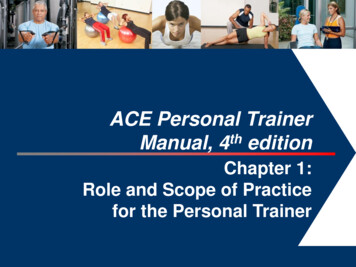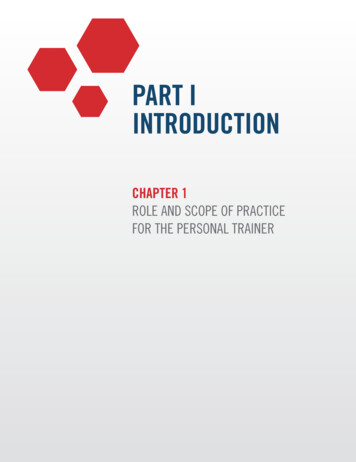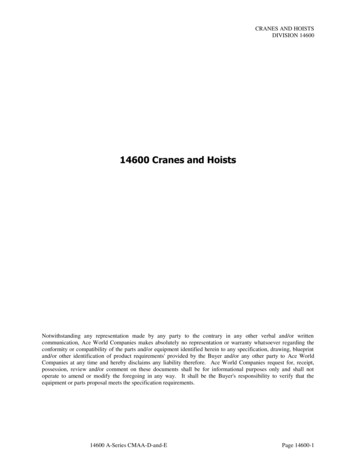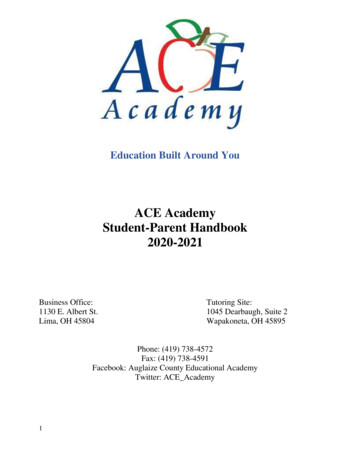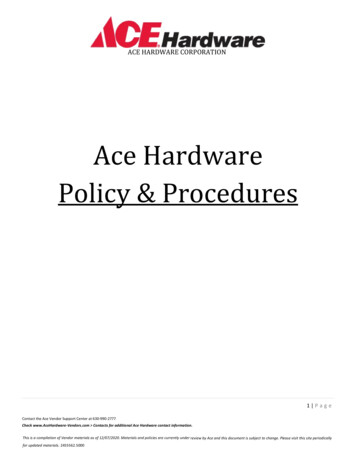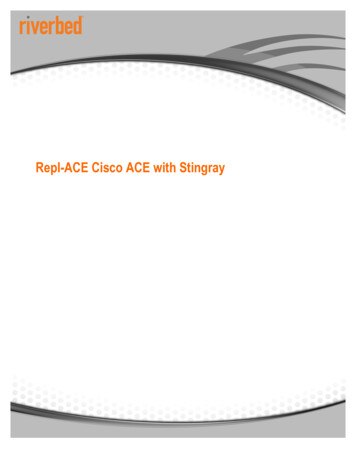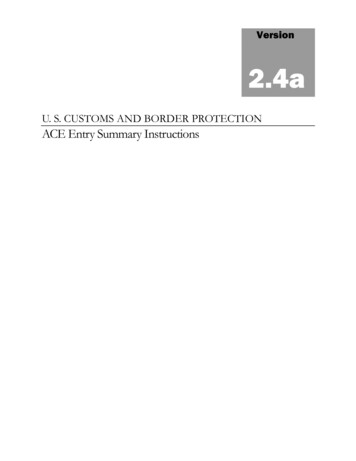
Transcription
Version2.4aU. S. CUSTOMS AND BORDER PROTECTIONACE Entry Summary Instructions
Automated Commercial Environment (ACE) ENTRY SUMMARYINSTRUCTIONSThe purpose of this document is to provide guidance to ACE end users on what entry summaryinformation to provide in ACE. The data elements that were originally on the paper CBP Form7501 will be provided online via ACE. The purpose of ACE is to minimize the retention of paperentry summary packets. The ACE Entry Summary Instructions will make references to the ACEAutomated Broker Interface (ABI) Customs and Trade Automated Interface Requirements(CATAIR).ENTRY SUMMARY HEADER LEVEL INFORMATIONFILER/REMOTE PREPARER CODERecord the entry summary filer’s identification and office location codes (as assigned by CBP)ENTRY NUMBERRecord the 11-digit alphanumeric code. The entry number is comprised of the 3-character filercode, followed by the 7-digit entry number, and completed with the one digit check digit.Entry Filer Code represents the 3-character alphanumeric filer code assigned to the filer orimporter by Customs and Border Protection (CBP).Entry Number represents the 7-digit number assigned by the filer. The number may be assignedin any manner convenient, provided that the same number is not assigned to more than one CBPentry summary. Leading zeros must be shown.Check digit is computed on the previous 10 characters. The formula for calculating the checkdigit can be found at following link Check Digit Computation Formula.DISTRICT/ PORT OF ENTRYRecord the U.S. port code utilizing the Schedule D, CBP District and Port Codes, listed in AnnexC of the Harmonized Tariff Schedule United States Annotated (HTS). The port is where themerchandise was entered under an entry or released under an immediate delivery permit. Use thefollowing format: DDPP (no spaces or hyphens).ENTRY TYPERecord the appropriate entry type code by selecting the 2-digit code for the type of entrysummary being filed. The first digit of the code identifies the general category of the entry (i.e.,consumption 0, informal 1. The second digit further defines the specific processing typewithin the entry category.1
The following codes shall be used and are the only entry types being supported in ACE at thistime:Consumption EntriesFree and Dutiable01Antidumping (AD) andCountervailing Duty (CVD) 03Informal EntriesFree and Dutiable11MODE OF TRANSPORT (MOT)Record the mode of transportation by which the imported merchandise entered the first U.S. portof arrival from the last foreign country utilizing the following two digit numeric codes:10 - Vessel, non-container (including all cargo at first U.S. port of unlading aboard a vesselregardless of later disposition; lightered, land bridge and LASH all included). If containerstatus unknown, but goods did arrive by vessel, use this code.11 - Vessel, container12 - Border, Waterborne (used in cases where vessels are used exclusively to ferryautomobiles, trucks, and/or rail cars, carrying passengers and baggage and/or cargo andmerchandise, between the U.S. and a contiguous country).20 - Rail, non-container21 - Rail, container30 - Truck, non-container31 - Truck, container32 - Auto33 - Pedestrian34 - Road, other40 - Air, non-container41 - Air, container50 - Mail60 - Passenger, hand-carried70 - Fixed transport installation (includes pipelines, powerhouse, etc.)BOND DETAIL Bond Type Code - the type of bond, either single or continuous, according to theconditions of 19 CFR 113.62.The bond information is reported at the header level of an ACE Entry Summary exceptfor AD/CVD Bonding Requirements. AD/CVD bonds are reported at the line level of anACE entry summary.2
8 continuous (multiple transaction) bond9 single transaction bond Bond Designation Type Code - a code indicating the purpose of the bond.Under ACE, an entry may have either a continuous bond or a continuous bond and asingle transaction bond, or two single transaction bonds, therefore it is necessary to havean indicator to designate which bond is the basic bond and which is the single transaction.The bonds may be reported in any order.B Basic bond; the bond either single or continuous that contains theconditions of 19 CFR 113.62 for entry and entry summary.A Single Transaction bond. Additional security when appropriate forAD/CVD, a PGA, or as required by statute, regulation, or directive. Continuous Superseded Bond Indicator - A conditional field used to indicate thecontinuous bond on the summary supersedes the bond used at time of entry.Y Continuous bond supersedes the bond presented at time of entry.Leave field blank, if not superseding or if a single transaction bond (STB) is obligated.Surety Code - Record the three digit numeric code that identifies the surety company onthe Customs Bond. Use '999' as the surety code, when there is no bond or bond is waivedby regulation. Bond type "9" should be used in conjunction with surety code "999" whenbond is waived in accordance with 19 CFR 142.2(c). Use ‘998’ as the surety code, whencash or government securities are deposited in lieu of surety. Bond type "8" or "9," asappropriate, should be used in conjunction with surety code "998". Single Transaction Bond Amount – STB coverage amount in whole U.S. dollars.Leave blank if a continuous bond. Single Transaction Bond Producer Account Number - The Entry Filer’s identificationnumber assigned by the Surety company of the STB.Leave blank if a continuous bond. No Bond; Bond Waived Indicator 0 Type 11 Informal Entry may be made without a bond if the importer is aservice man returning from foreign duty and the shipment is personaleffects, or if the value of the merchandise the bond would secure does not3
exceed 2,500 and waiver is obtained from the port director prior to releaseof the merchandise under 19 CFR 142.4(c) (1). The bond cannot be waived for anexplicit AD/CVD Entry Type. Bond Waiver Reason Code‘998’ When cash or government securities are deposited in lieu of surety.'999' When an informal entry is made for personal effects, or the importer hasobtained waiver of the bond prior to release under 19 CFR 142.4(c)(1). AD/CVD Bonding RequirementsCertain AD/CVD submission scenarios require a Single Transaction Bond (STB) be citedin the Bond Detail field.When Filer’sBond/CashClaim:Scenario 1 All claims forall cases C(Cash)WhenAD/CVD CaseRates are:n/aScenario 2 - Any one claim B (Bonded) and the rate forthat case is a Specific Rate.Scenario 3 - No bonded,specific case found; all other B(Bonded) claims are where theAd Valorem Rate 5%.Bond DetailSubmissionConfiguration:Allowed?Continuous OnlyYesOne STB OnlyYesContinuous STBYesTwo STBYesContinuous OnlyNoOne STB OnlyYesContinuous STBYesTwo STBYesContinuous OnlyYesOne STB OnlyYesContinuous STBYes4NoteAny configurationallowed when allAD/CVD revenue iscash payment. Anadditional STB, ifsubmitted, isassumed to be for anon-AD/CVDpurpose.A ‘specific’ ratebonded case alwaysrequires an STB. Acontinuous bondonly, therefore, isnever allowed.As long as there is no‘specific’ rate bondedclaim, anyconfiguration allowedwhen all bondedcase ad valoremrates are below 5%.The Filer’scontinuous bond, if
Scenario 4 - No bonded,specific case found; any singleB (Bonded) claim where theAd Valorem Rate or 5%.Two STBYesContinuous OnlyNoOne STB OnlyYesContinuous STBYesTwo STBYesclaimed is allowed forthe additionalAD/CVD coverage.An additional STB, ifsubmitted, may befor AD/CVDpurposes or for anon-AD/CVDpurpose.A ‘5% or greater advalorem rate’ bondedcase always requiresan STB. Acontinuous bondonly, therefore, isnever allowed.ELECTRONIC SUMMARY CERTIFICATIONA mandatory field when an ACE Entry Summary is being added or replaced. An “X” in theelectronic field represent the Filer’s electronic signature. An ACE Entry Summary is designatedas paperless until such time (if any) that CBP requests that a paper document be submitted.CARGO RELEASE CERTIFICATION REQUESTA conditional field used by the filer when instructing CBP to use the Entry Summaryinformation for the purpose of Cargo Release (i.e., create/process an Entry for the release of thecargo).A “Y” is used when certifying that Entry Summary information will be used for Cargo Releasepurposes.The results of the request for Cargo Release Certification shall be returned to the Filer in aseparate EDI response.ELECTRONIC INVOICE INDICATORAn indication that the Entry Summary conforms to the requirements for Electronic InvoiceProcessing (EIP) program via the Automated Invoice Interface (AII): an electronic invoice(s)that accounts for ALL articles claimed on the Entry Summary has EITHER – a) been submittedelectronically to CBP, or b) is available for electronic submission when requested by CBP.A “Y” is used when the electronic invoice is available.5
Leaving this field blank will indicate that the electronic invoice is not available.CONSOLIDATED SUMMARY INDICATORA conditional field using a “Y” to indicate that the Entry Summary accounts for (i.e.,‘consolidates’) the cargo referenced in more than one Cargo Release (entry) transaction.SHIPMENT USAGE TYPE CODEA conditional field used to indicate that the articles referenced in the summary are for personaluse or designated as a commercial sample.P Personal Shipment.X Sample Commercial Shipment.LIVE ENTRY INDICATORA conditional field using a “Y” to indicate both Entry Summary & Entry are filed at time ofentry (required for importation of quota class merchandise); i.e., a live entry.NAFTA RECONCILIATION INDICATORA conditional field using a “Y” to indicate that certain issues (such as value, classification, etc.)are to be subject to a future ‘reconciliation’ for NAFTA.OTHER RECONCILIATION INDICATORA conditional field using a “Y” to indicate that certain issues (such as value, classification, etc.)are to be subject to a future ‘reconciliation’ other than NAFTA.RECONCILIATION STATUS CODESRecord the appropriate reconciliation status code by selecting the three digit code for the type ofreconciliation status being filed.The following are the Reconciliation Issue Codes:001 Value.002 Classification.003 Chapter 9802.004 Value & Classification.005 Value and Chapter 9802.006 Classification & Chapter 9802.007 Value, Classification & Chapter 9802.6
PAYMENT TYPERecord the single digit numeric code as follows:1 Individual payment (NOT on a statement).Note: Only allowed AFTER an ACE Entry Summary has been removed from the statement.On DAILY statement corresponding to the Preliminary Statement Print Date:2 Entries sequenced by Broker Reference Number (if pre-arranged) or by Entry Number.3 Entries sequenced by Importer of Record & subdivision suffix.5 Entries sequenced by Importer of Record (no suffix).On PERIODIC MONTHLY statement corresponding Periodic Statement Month. To appear onthe DAILY statement corresponding to the Preliminary Statement Print Date:6 Entries sequenced by Broker Reference Number (if pre-arranged) or by Entry Number.7 Entries sequenced by Importer of Record & subdivision suffix.8 Entries sequenced by Importer of Record (no suffix).PRELIMINARY STATEMENT PRINT DATEThe date that the Entry Summary is to appear on the Preliminary Statement.Statement fields are not allowed when correcting/amending an Entry Summary that has been‘returned’ to the filer after the initial payment has been made (e.g., ‘rejected’ by an ImportSpecialist).PERIODIC STATEMENT MONTHThe calendar month that the Entry Summary is accounted for on the Preliminary PeriodicMonthly Statement. (MM Format).Statement fields are not allowed when correcting/amending an Entry Summary that has been‘returned’ to the filer after the initial payment has been made (e.g., ‘rejected’ by an ImportSpecialist).STATEMENT CLIENT BRANCH IDENTIFIERA Filer assigned code that further groups Entry Summaries on a statement.Statement fields are not allowed when correcting/amending an Entry Summary that has been‘returned’ to the filer after the initial payment has been made (e.g., ‘rejected’ by an ImportSpecialist).7
ARTICLE PARTY HEADERThe Article Party Header contains party identifiers relevant to the article. The type of Partyreported includes the importer of record, consignee, and designated notify (4811). Importer of Record NumberRecord the IRS EIN, SSN, or CBP assigned number of the importer of record. Properformat is listed under the instructions for Consignee Number. Importer of Record Name and AddressRecord the name and address, including the standard postal two-letter state or territoryabbreviation, of the importer of record. The importer of record is defined as the owner orpurchaser of the goods, or when designated by the owner, purchaser, or consignee, alicensed customs broker. The importer of record is the individual or firm liable forpayment of all duties and meeting all statutory and regulatory requirements incurred as aresult of importation, as described in 19 C.F.R. § 141.1(b). The importer of record shownon the invoice should be the same party on the ACE entry summary, unless the CBP formreflects a licensed customs broker. Consignee NumberRecord the entity in the United States on whose account the merchandise is shipped. Usethe Internal Revenue Service (IRS) Employee Identification Number (EIN), SocialSecurity Number (SSN), or CBP assigned number of the consignee.The “Consignee” information at the header level for the entry summary must bemaintained for cargo release and the Importer Security Filing (ISF) related purposes.For express consignment shipments, consolidated summaries, or when entry type is 11(Informal), the consignee may be reported in a suitable format as all zeros (e.g., ‘000000000‘). Consignee Name and AddressAt the time of entry summary, record the name and address of the consignee that wasreported in the Consignee Number field. Designated Notify Party (4811) NumberA conditional field that is the identification of the U.S. party or other entity (individual orfirm) to whom refunds, bills, or notices of
The data elements that were originally on the paper CBP Form 7501 will be provided online via ACE. The purpose of ACE is to minimize the retention of paper entry summary packets. The ACE Entry Summary Instructions will make references to the ACE Automated Broker Interface (ABI) Customs and Trade Automated Interface Requirements (CATAIR).
